Mazda CX-3: i-ACTIVSENSE / Rear Cross Traffic Alert (RCTA)(Some models)
The RCTA system is designed to assist the driver in checking the area to the rear of the vehicle on both sides while the vehicle is reversing by alerting the driver to the presence of vehicles approaching the rear of the vehicle. The RCTA system detects vehicles approaching from the rear left and right sides of the vehicle, and the rear of the vehicle while the vehicle is being reversed out of a parking space, and notifies the driver of possible danger using the Blind Spot Monitoring (BSM) warning indicator lights and the warning buzzer.
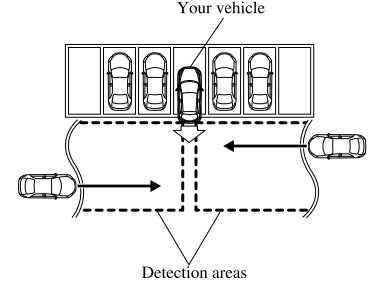
RCTA operation
The RCTA system operates when the shift lever (manual transaxle) or the selector lever (automatic transaxle) is shifted to the reverse (R) position.
If there is the possibility of a collision with an approaching vehicle, the Blind Spot Monitoring (BSM) warning indicator lights flashes and the warning beep is activated simultaneously.
The RCTA warning indication in the rearview monitor also synchronizes with the Blind Spot Monitoring (BSM) warning indicator light on the door mirrors.
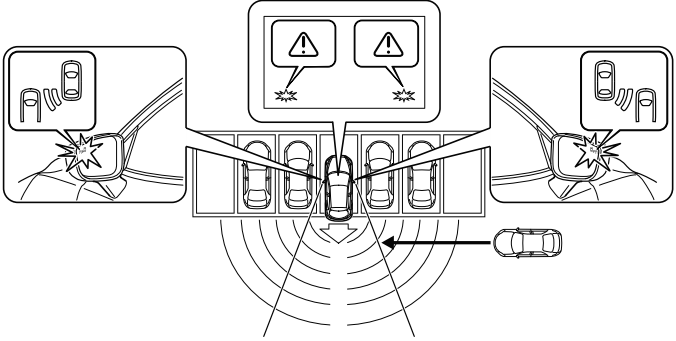
WARNING
Always check the surrounding area visually before actually putting the vehicle in reverse: The system is only designed to assist you in checking for vehicles at the rear when putting the vehicle in reverse. Due to certain limitations with the operation of this system, the Blind Spot Monitoring (BSM) warning indicator lights may not flash or it might be delayed even though a vehicle is behind your vehicle. Always make it your responsibility as a driver to check the rear.
NOTE
- In the following cases, the Blind Spot Monitoring (BSM) OFF
Indicator Light turns on
and operation of the system is stopped. If the Blind Spot Monitoring (BSM)
OFF Indicator
Light remains illuminated, have the vehicle inspected at an Authorized Mazda
Dealer as
soon as possible.
- Some problem with the system including the Blind Spot Monitoring (BSM) warning indicator lights has occurred.
- A large deviation in the installation position of a radar sensor (rear) on the vehicle has occurred.
- There is a large accumulation of snow or ice on the rear bumper near a radar sensor (rear).
- Driving on snow-covered roads for long periods.
- The temperature near the radar sensors becomes extremely hot due to driving for long periods on slopes during the summer.
- The battery voltage has decreased.
- Under the following conditions, the radar sensors (rear) cannot
detect target objects or it
may be difficult to detect them.
- The vehicle speed when reversing is about 10 km/h (6 mph) or faster.
- The radar sensor (rear) detection area is obstructed by a nearby wall or parked vehicle. (Reverse the vehicle to a position where the radar sensor detection area is no longer obstructed.)
-
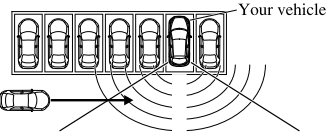
- A vehicle is approaching directly from the rear of your vehicle.
-
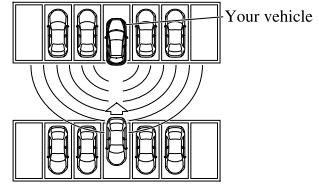
- The vehicle is parked on a slant.
-
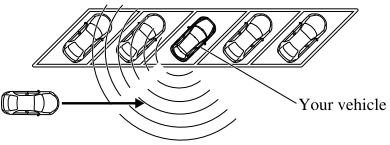
- Directly after the Blind Spot Monitoring (BSM) system becomes operable using the personalization feature.
- Radio wave interference from a radar sensor equipped on a nearby parked vehicle.
- In the following cases, it may be difficult to view the
illumination/flashing of the Blind
Spot Monitoring (BSM) warning indicator lights equipped on the door mirrors.
- Snow or ice adheres to the door mirrors.
- The front door glass is fogged or covered in snow, frost or dirt.
- Turn off the RCTA system while pulling a trailer or while an accessory such as a bicycle carrier is installed to the rear of the vehicle. Otherwise, the radio waves emitted by the radar will be blocked causing the system to not operate normally.
 Distance Recognition Support System (DRSS) (Some models)
Distance Recognition Support System (DRSS) (Some models)
The DRSS measures the distance between your vehicle and a vehicle ahead using
a radar
sensor (front) while the vehicle speed is about 30 km/h (19 mph) or faster, and
if your
vehicle approaches a vehicle ahead more closely than what is appropriate for
maintaining
distance between the vehicles according to the vehicle speed, a notification in
the active
driving display is indicated to advise you to keep a safe distance from the
vehicle ahead...
 Mazda Radar Cruise Control with Stop & Go function (MRCC with Stop & Go
function) (Some models)
Mazda Radar Cruise Control with Stop & Go function (MRCC with Stop & Go
function) (Some models)
The MRCC with Stop & Go function system is designed to maintain headway
control*1
with a vehicle ahead according to your vehicle's speed using a radar sensor (front)
to detect
the distance to the vehicle ahead and a preset vehicle speed without you having
to use the
accelerator or brake pedals...
Other information:
Mazda CX-3 (2015-2026) Owner's Manual: Displayable Range on the Screen
The images on the screen may be different from the actual conditions. NOTE The displayable range varies depending on the vehicle and road conditions. The displayable range is limited. Objects under the bumper or around the bumper ends cannot be displayed...
Mazda CX-3 (2015-2026) Owner's Manual: Radio Reception
AM characteristics AM signals bend around such things as buildings or mountains and bounce off the ionosphere. Therefore, they can reach longer distances than FM signals. Because of this, 2 stations may sometimes be picked up on the same frequency at the same time...
Categories
- Manuals Home
- Mazda CX-3 Owners Manual
- Mazda CX-3 Service Manual
- Luggage Compartment
- Recommended Oil
- Daytime Running Lights
- New on site
- Most important about car
Outside Mirrors
WARNING
Be sure to look over your shoulder before changing lanes:
Changing lanes without taking into account the actual distance of the vehicle in the convex mirror is dangerous. You could have a serious accident. What you see in the convex mirror is closer than it appears.
Mirror type
Flat type (driver's side)
